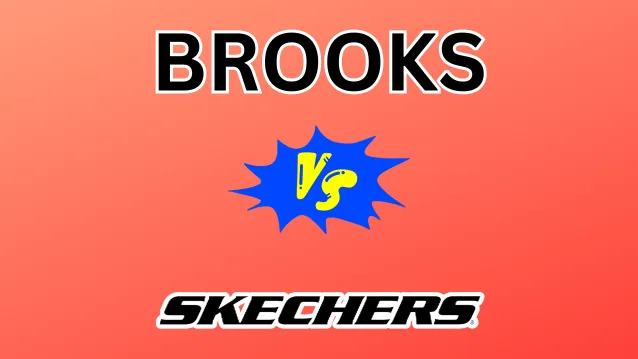As an avid runner, I’m always looking for shoes that provide the right blend of comfort, support, and durability to meet my needs.
Having tried both Brooks and Skechers shoes over the years, I decided to compare the key features of these two popular running shoe brands to help fellow runners choose the right option for them.
Both have their own technologies and design philosophies, but how do they stack up across critical factors like fit, cushioning, traction, and more? Read on for my in-depth analysis.
Comparison Table Between Brooks And Skechers:
| Features | Brooks | Skechers |
|---|---|---|
| Founded In | 1914 | 1992 |
| Comfort and Fit | Exceptional comfort with padded heel collar and available wide widths | Comfortable memory foam and breathable uppers |
| Color Options | Classic and vibrant options | Diverse colors and prints |
| Durability | Durable materials withstand miles of wear | Long-lasting outsoles and durable uppers |
| Performance | BioMoGo DNA cushioning provides adaptive padding | Memory foam and Hyper Burst foam enable soft landings |
| Design and Style | Streamlined, performance-focused aesthetic | Athletic style fused with casual lifestyle design |
| Popularity | Popular with serious runners | Wide mainstream appeal |
| Best Selling Model | Adrenaline GTS | Go Walk shoes |
Brooks Overview:
Brooks running shoes originated in 1914 in Seattle, Washington when the Brooks Shoe Company was founded. Though it started as a specialty shoe brand, Brooks eventually pivoted to focus on athletic and performance footwear in the 1970s.
Some of the long-running iconic features of Brooks shoes include:
- BioMoGo DNA: An adaptive midsole foam that provides soft landings followed by firm toe-offs for propulsion.
- GuideRails: An engineered support system around the midsole to limit excess pronation or inward foot rolling.
- Flextra: Outsole rubber strategically placed for flexibility where the foot needs to move.
- Ideal Pressure Zones: Designated cushioned zones on the outsole positioned under important areas.
- Adjustable saddle: A structured component that customizes midfoot support and fit.
- HydroFlow: Shock-absorbing cushioning units in the midsole for plush softness.
In addition to catering to regular neutral runners, Brooks offers stability, trail, walking, and casual shoes. Some of their most popular models through the years include the Ghost, Adrenaline GTS, Glycerin, and Ravenna.
With over 100 years of experience, Brooks uses proven technologies and innovations to create high-performance shoes suited for runners of all types. Their wide selection and consistent fit keep runners coming back year after year.
Skechers Brand Overview
Founded in Manhattan Beach, California in 1992 by Robert Greenberg, Skechers has grown into a leading global footwear brand.

Skechers designs comfortable, supportive, and stylish shoes for walking, running, training, and casual wear.
They incorporate innovations like high-rebound cushioning, Memory Foam insoles, Relaxed Fit designs and slip-resistant outsoles to provide versatility across active lifestyles.
Their Pressure Map technology uses real-time testing data to optimize comfort and support.
Skechers offers on-trend athletic and casual looks in various colors to appeal to diverse tastes. With affordably priced options for men and women, Skechers remains popular for their wear-anywhere comfort and style.
Their lightweight GOwalk shoes are a top choice for all-day wear. For athletic performance with mainstream appeal, Skechers delivers.
Major Differences Between these Brands
1) Comfort and Fit
When your running shoes feel like slippers crafted perfectly for your feet after long miles, you’ve found the right fit. Both Brooks and Skechers aim to pamper feet with plush interiors, but their comfort approaches differ.
The contoured heel collars, 3D print overlays, and available wide widths of Brooks shoes conform intimately to your distinct foot shape for a precision glove-like fit.
2) Durability and Performance
With running shoes taking constant abuse from pavement-pounding training, durability, and traction translate directly into miles logged before you need to replace them.
Brooks excels here by engineering high-abrasion rubber outsoles and durable upper fabrics specifically to withstand over 500 miles of training for many models.
3) Price
Great performance often carries premium pricing, which explains the significant MSRP gap between Brooks and Skechers shoes. Core neutral Brooks models retail from $100-150 while comparable Skechers run $60-100.
Despite 20-30% lower listing prices, Skechers come very close to matching essential running shoe features like lightweight cushioning, breathable upper fabrics and support components.
4) Design and Style
Style matters for runners who want shoes that turn heads at the gym and coffee shop alike. Skechers’ heritage DNA infuses even their performance shoes with athletic lifestyle panache in on-trend colors and prints.
Tie-dye, camo and graffiti patterns pop beside neon brights and muted earth tones in their collections.
5) Popularity
As the #1 specialty running brand nationwide, Brooks enjoys an exceptional word-of-mouth reputation and repeat purchases from devoted runners.
Racing icons like Des Linden and track clubs proudly sport the Brooks brand. Skechers has earned mainstream popularity as a lifestyle brand while making strides recently as a legitimate performance shoe company.
7) Target Market
With advanced product development centered on hardcore runners, it makes sense Brooks targets competitive racers logging 40+ miles weekly in training.
Optimized foam rebound, stability guides, and durability serve their needs best. Skechers seeks broader appeal from weekend 5K’ers to athletes dabbling in gym training or sports.
Final Verdict
In the Brooks vs Skechers head-to-head, Brooks claims the competitive runner market with dialed performance and premium construction quality.
But Skechers proves serious competition on technology can come in an affordably stylish package for nearly any activity. Their niche strengths aside, either brand can ably meet most neutral runners’ daily training demands.
You’ll relish the DNA lineage of Brooks or the lifestyle infusion of Skechers based on personal priorities around resilience, price, pronation support and aesthetic charm. Any way you lace them up, both brands deliver comfort and versatility over miles of personalized progress chasing your potential.

